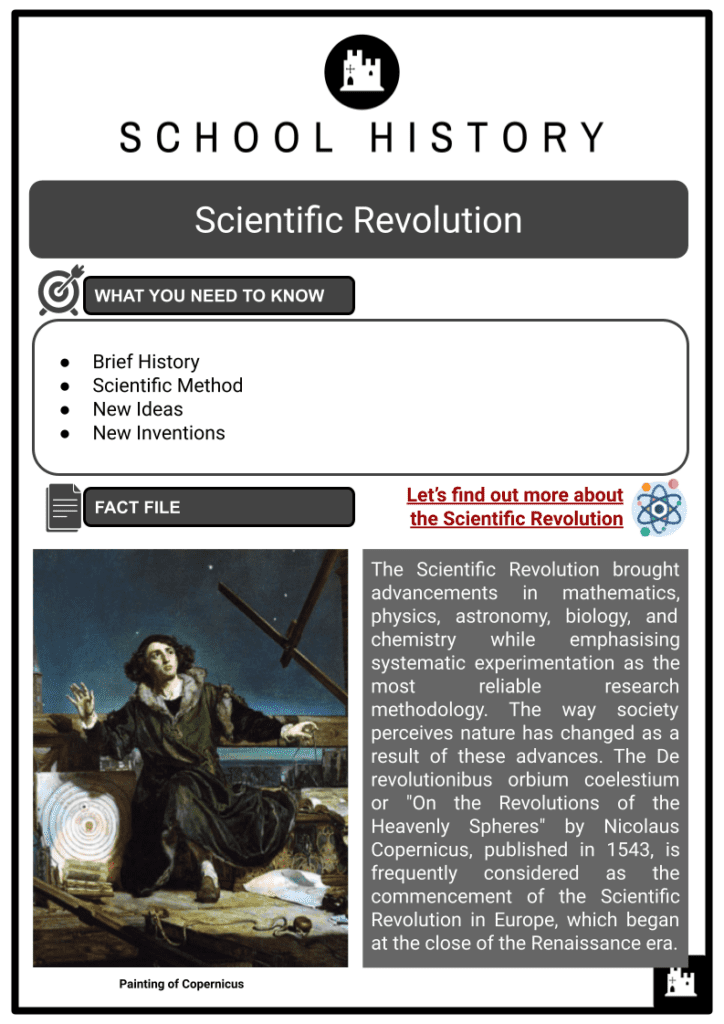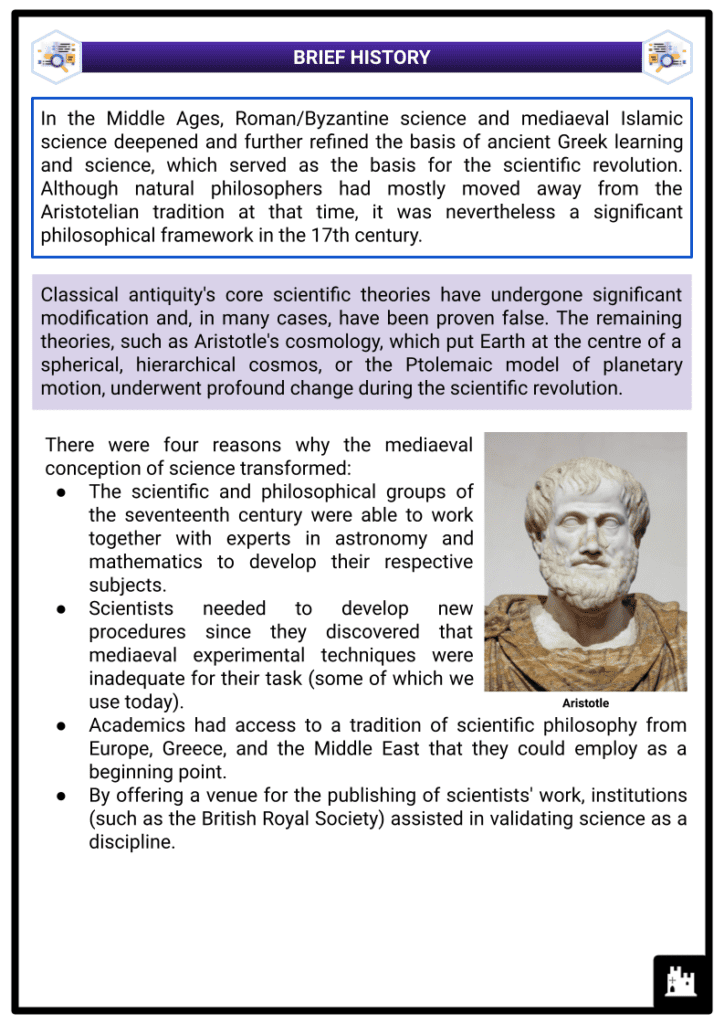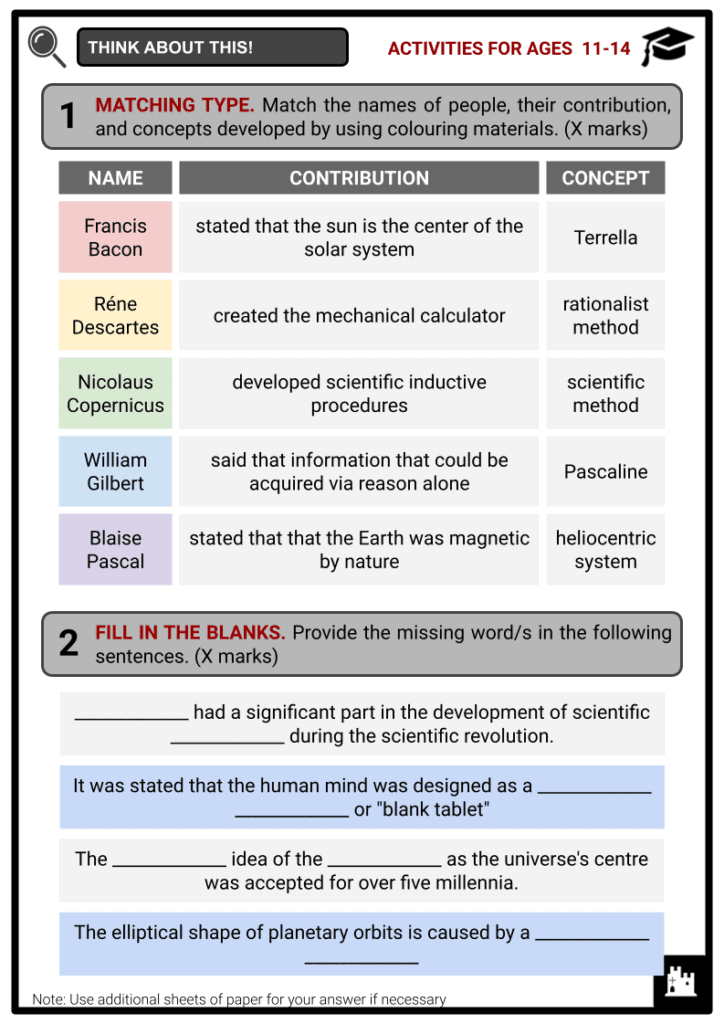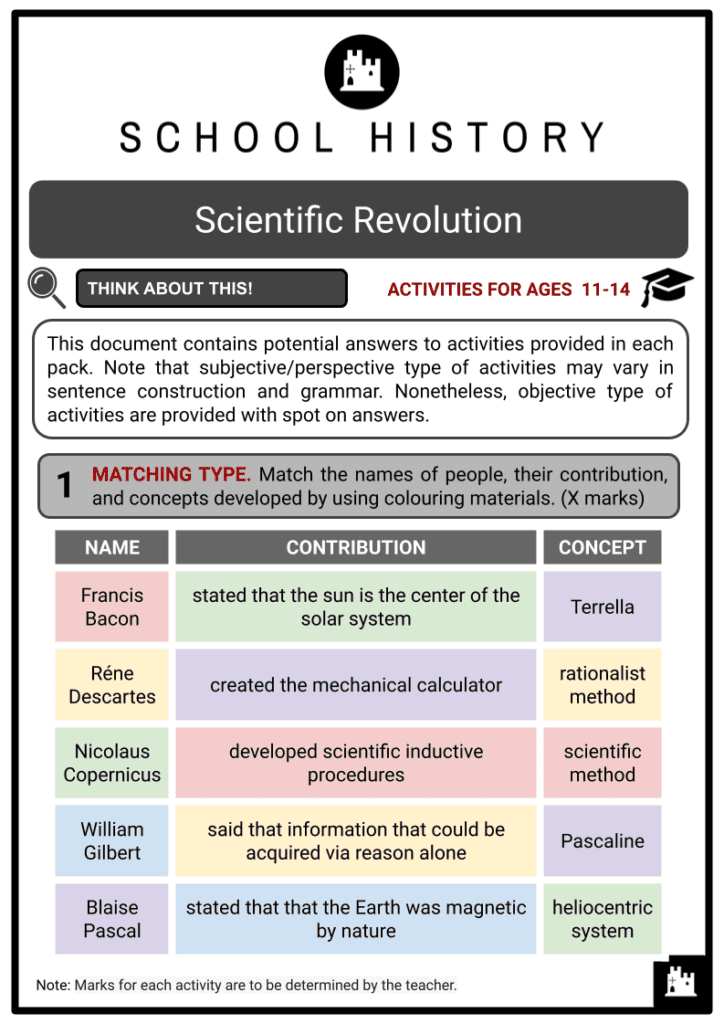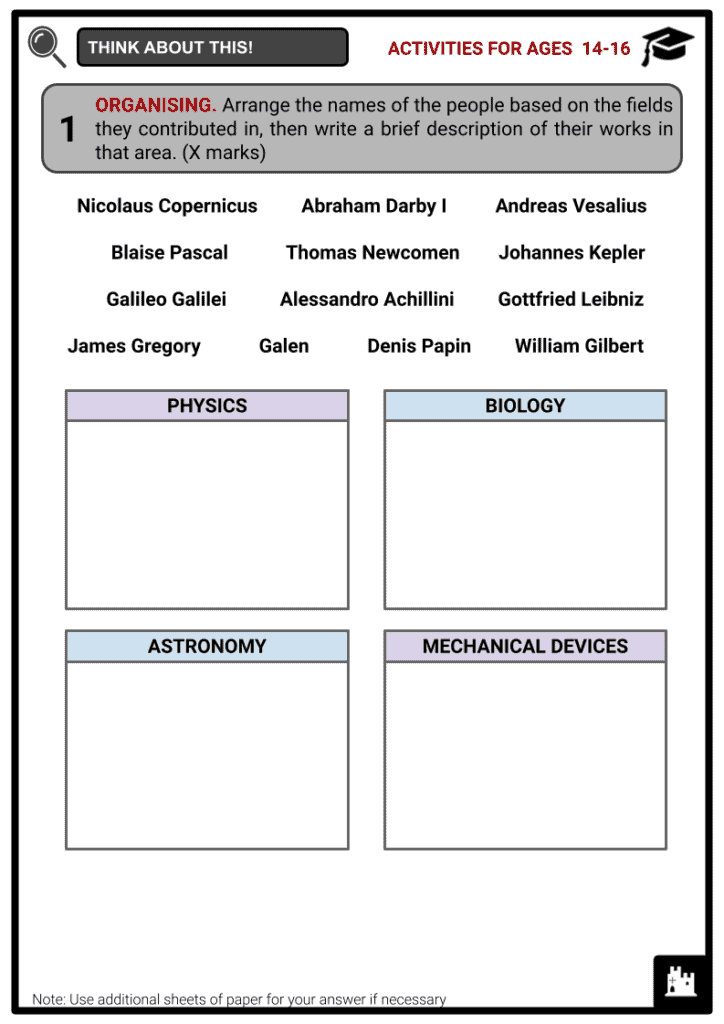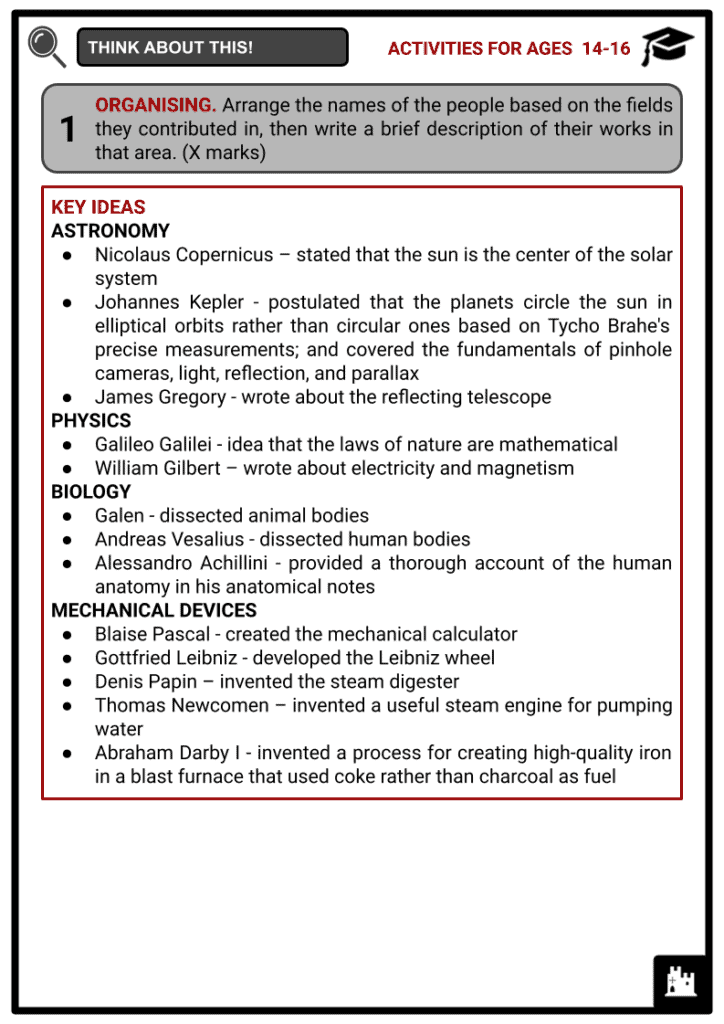Scientific Revolution Worksheets
Do you want to save dozens of hours in time? Get your evenings and weekends back? Be able to teach about the Scientific Revolution to your students?
Our worksheet bundle includes a fact file and printable worksheets and student activities. Perfect for both the classroom and homeschooling!
Summary
- Brief History
- Scientific Method
- New Ideas
- New Inventions
Key Facts And Information
Let’s find out more about the Scientific Revolution!
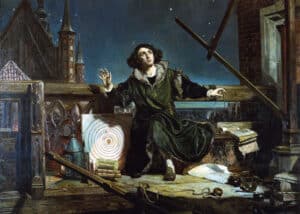
The Scientific Revolution brought advancements in mathematics, physics, astronomy, biology, and chemistry while emphasising systematic experimentation as the most reliable research methodology. The way society perceives nature has changed as a result of these advances. The De revolutionibus orbium coelestium or "On the Revolutions of the Heavenly Spheres" by Nicolaus Copernicus, published in 1543, is frequently considered as the commencement of the Scientific Revolution in Europe, which began at the close of the Renaissance era.
BRIEF HISTORY
- In the Middle Ages, Roman/Byzantine science and mediaeval Islamic science deepened and further refined the basis of ancient Greek learning and science, which served as the basis for the scientific revolution. Although natural philosophers had mostly moved away from the Aristotelian tradition at that time, it was nevertheless a significant philosophical framework in the 17th century.
- Classical antiquity's core scientific theories have undergone significant modification and, in many cases, have been proven false. The remaining theories, such as Aristotle's cosmology, which put Earth at the centre of a spherical, hierarchical cosmos, or the Ptolemaic model of planetary motion, underwent profound change during the scientific revolution.
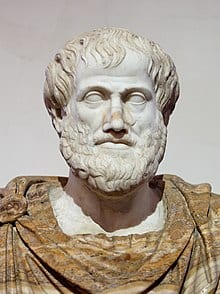
Aristotle - There were four reasons why the mediaeval conception of science transformed:
- The scientific and philosophical groups of the seventeenth century were able to work together with experts in astronomy and mathematics to develop their respective subjects.
- Scientists needed to develop new procedures since they discovered that mediaeval experimental techniques were inadequate for their task (some of which we use today).
- Academics had access to a tradition of scientific philosophy from Europe, Greece, and the Middle East that they could employ as a beginning point.
- By offering a venue for the publishing of scientists' work, institutions (such as the British Royal Society) assisted in validating science as a discipline.
SCIENTIFIC METHOD
- Natural and artificial conditions were abandoned under the scientific method that was established and used in the 17th century, and a research tradition of methodical experimentation was gradually embraced across the scientific community. The older, Aristotelian approach of deduction, through which examination of existing facts created more insight, was in stark contrast to the idea of utilising an inductive approach to nature (to renounce assumption and to strive to simply observe with an open mind). In reality, many scientists and philosophers thought that a healthy balance of both was required—the ability to interpret findings while also being prepared to challenge presumptions.
- The key way that the Aristotelian scientific tradition interacted with the outside world was through observation and reasoning about "natural" events. This strategy was accompanied by the idea that unusual occurrences that appeared to defy theoretical predictions were aberrations and didn't reveal anything about nature as it "naturally" was.
- Empiricism had a significant, but not only, part in the development of scientific methodology during the scientific revolution due to shifting views on the function of the scientist in relation to nature and the importance of experimental or observable data.
- The phrase, “British empiricism”, was coined to refer to the philosophical slant that two of its founders, Francis Bacon, an empiricist, and René Descartes, a rationalist, held.
- The scientific method, sometimes known as the Baconian technique or simply the scientific process, was devised and made famous by Bacon.
- His insistence on a methodical approach to researching everything natural signalled a change in the rhetorical and theoretical foundation for science, much of which still surrounds ideas of appropriate technique in modern times.
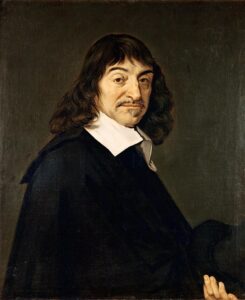
René Descartes - Descartes made a similar distinction between information that could be acquired via reason alone (rationalist method), such as in mathematics, and knowledge that required firsthand contact with the outside world, such as in physics.
- Francis Bacon, known as the "father of empiricism," created the philosophical foundation for the Scientific Revolution. His writings pioneered and popularised scientific inductive procedures, sometimes known as the Baconian method or the scientific method. His insistence on a methodical approach to researching everything natural signalled a change in the rhetorical and theoretical foundation for science, much of which still surrounds ideas of appropriate technique in modern times.
- To promote both divine and human learning, Bacon advocated a major reformation of all knowledge processes. He named this initiative Instauratio Magna (The Great Instauration). According to Bacon, this reformation would result in a significant progress in knowledge and the birth of new technologies that would address the wants and ills of mankind. In 1620, his Novum Organum was published.
- Bacon believed that it was more important for science to work toward improving human life through inventions rather than continuing to engage in intellectual debates or pursue purely contemplative goals. He investigated the broad impact and paradigm-shifting nature of innovations like the printing press, gunpowder, and the compass.
- Steps of the Scientific Method
- Identify the problem
- Form a hypothesis
- Perform experiments to test the hypothesis
- Analyse the results of the experiment
- Conclusion
- William Gilbert promoted the experimental approach before anybody else. He strongly disagreed with both the prevalent Aristotelian philosophy and the Scholastic approach to higher education. He wrote the book De Magnete in 1600, and some people consider him to be the founder of electricity and magnetism. He explains a lot of his experiments with his model Earth, the terrella, in this work. He deduced from these trials that the Earth was magnetic by nature, which is why compasses point north.
- John Locke's “An Essay Concerning Human Understanding” (1689), which argued that only information derived from experience could be considered true, was a significant contribution to the development of empiricism. According to him, the human mind was designed as a tabula rasa, or "blank tablet," where sensory impressions could be stored and knowledge could be built up via reflection.
- As the "father of modern observational astronomy," "father of modern physics," "father of science," and "the Father of Modern Science," Galileo Galilei has earned several honorific titles. Through a creative fusion of experiment and mathematics, he made groundbreaking advances to the study of motion.
- The idea that the laws of nature are mathematical was initially articulated by one of the first modern philosophers, Galileo. He had to establish standards of time and length in order to carry out his experiments. This was necessary so that measurements taken on various days and in various labs could be compared and verified. This offered a solid basis for inductively verifying the validity of mathematical laws. Galileo demonstrated an understanding of how mathematics, theoretical physics, and experimental physics are related.
NEW IDEAS
- All astronomers, with the exception of a few, have accepted the geocentric idea of the Earth as the universe's centre for over five millennia. As opposed to the "heavens" (Moon, Sun, planets, stars), which were viewed as perfect, permanent, unchangeable, and in religious thought, the realm of heavenly beings, the Earth was identified by Aristotle as a realm of imperfection, inconstancy, irregularity, and change. This distinction may have been more important than the Earth's central position in Aristotle's cosmology.
- The heliocentric model that succeeded it featured not only the drastic relocation of the earth to an orbit around the sun, but also the implication that the universe's other planets were constructed of the same malleable materials as the Earth by virtue of their shared location with the Earth.
- Heavenly movements no longer had to be constrained to circular orbits and guided by a theoretical perfection.
- The heliocentric model of the solar system developed by Copernicus in 1543 sought to prove that the sun stood at the centre of the universe.
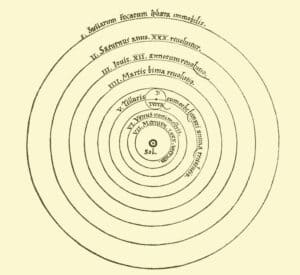
Heliocentrism - This notion didn't upset many people, but the pope and a few archbishops were intrigued enough to demand additional information.
- Due to the lack of a discernible star parallax, it contradicted not only scientific observation, but also—and this was more relevant at the time—the authority of Aristotle.
- The idea gained support from Galileo and Johannes Kepler's discoveries. Astronomer Kepler postulated that the planets circle the sun in elliptical orbits rather than circular ones based on Tycho Brahe's precise measurements. The Aristotelian philosophy and the Ptolemaic view of the solar system were both refuted by Galileo's observations of the moons of Jupiter, Venus' phases, the sun's spots, and the moon's mountains. The heliocentric system gained acceptance as a result of their joint findings, and by the end of the 17th century, astronomers had come to embrace it as the most likely explanation.
- Isaac Newton's work served as the pinnacle of this effort.
- The principles of motion and universal gravity were established in Newton's “Principia”, which shaped scientists' understanding of the physical universe for the following three centuries.
- Newton not only proved the heliocentric model but also established the theory of gravity.
- Newton started thinking about gravity and how it affected planet orbits in 1679, using Kepler's equations of planetary motion as a guide.
- The elliptical shape of planetary orbits would be caused by a centripetal force that is inversely proportional to the square of the radius vector, Newton proved after his discussions with Robert Hooke.
- “De motu corporum in gyrum”, published in 1684, was how Newton shared his findings with the Royal Society and Edmond Halley. The core of the Principia, which Newton extended and refined, was found in this tract.
- Edmond Halley provided financial support as well as encouragement for the 5 July 1687 publication of “The Principia”. The three universal laws of motion, which Newton outlined in this work and which would not be improved upon for more than 200 years, had a major role in the Industrial Revolution that soon followed. Many of these developments still serve as the foundation for non-relativistic technology today. He developed the rule of universal gravitation and named the phenomenon that would later be known as gravity using the Latin term gravitas (weight).
- Galen dissected animal bodies, whereas Vesalius dissected human bodies. Vesalius', which was published in 1543, revolutionised our understanding of human anatomy. It prioritised dissection and what has come to be known as the "anatomical" view of the body, which sees interior human functioning as a primarily corporeal system packed with organs arranged in three dimensions.
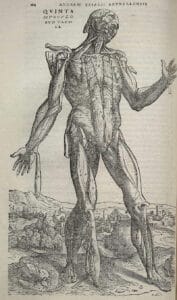
Illustrations in De humani corporis fabrica - Prior to Vesalius, Alessandro Achillini provided a thorough account of the human anatomy in his anatomical notes. He also made comparisons between what he discovered during his dissections and what others like Galen and Avicenna had discovered, noting both their parallels and contrasts.
- Astronomiae Pars Optica, also known as The Optical Part of Astronomy, was published by Johannes Kepler in 1604. He covered the fundamentals of pinhole cameras, the inverse-square rule determining light intensity, reflection by flat and curved mirrors, and the astronomical aspects of optics including parallax and the apparent sizes of celestial bodies. Most people agree that Astronomiae Pars Optica served as the foundation for modern optics.
- Newton proposed the presence of the ether to convey forces between particles in his Hypothesis of Light of 1675. Newton's Opticks, which outlined his corpuscular theory of light, was published in 1704. He believed that light was composed of incredibly fine corpuscles, whereas regular matter was composed of larger corpuscles, and he hypothesised that by some sort of alchemical transformation.
NEW INVENTIONS
- James Gregory wrote about the reflecting telescope in his work Optica Promota. He claimed that the spherical aberration that compromised the precision of refracting telescopes could be fixed by a mirror formed like a portion of a conic section. The "Gregorian telescope," which was his invention, was never fulfilled. Isaac Newton said in 1666 that the refracting telescope had basic flaws since the lens distorted light of various hues differently.
- Newton deduced from his trials that the refracting telescope could not be improved. He was able to show that the angle of reflection was constant for all hues, thus he made the decision to construct a reflecting telescope. It is the earliest known functional reflecting telescope and was finished in 1668.
- In 1642, Blaise Pascal created the mechanical calculator. His Pascaline, released in 1645, served as the catalyst for the global development of mechanical calculators, initially in Europe. Building on Pascal's work, Gottfried Leibniz developed the Leibniz wheel, which was utilised in the arithmometer, the first mass-produced mechanical calculator. He was one of the most creative innovators in the field of mechanical calculators. In 1685, he was the first to define a pinwheel calculator. Additionally, he improved the binary number system, which is the basis of almost all contemporary computer designs.
- The steam digester, which was the predecessor of the steam engine, was invented by Denis Papin in 1679. The Newcomen steam engine, which Thomas Newcomen perfected, is a useful steam engine for pumping water. Thomas Newcomen can therefore be viewed as a pioneer of the Industrial Revolution. Abraham Darby I invented a process for creating high-quality iron in a blast furnace that used coke rather than charcoal as fuel. The production of iron as a raw material for the Industrial Revolution advanced significantly as a result.
Image Sources
- https://en.wikipedia.org/wiki/Scientific_Revolution#/media/File:Nikolaus_Kopernikus_2.jpg
- https://en.wikipedia.org/wiki/Aristotle#/media/File:Aristotle_Altemps_Inv8575.jpg
- https://en.wikipedia.org/wiki/Ren%C3%A9_Descartes#/media/File:Frans_Hals_-_Portret_van_Ren%C3%A9_Descartes.jpg
- https://upload.wikimedia.org/wikipedia/commons/2/28/Copernican_heliocentrism_diagram-2.jpg
- https://en.wikipedia.org/wiki/De_Humani_Corporis_Fabrica_Libri_Septem#/media/File:Vesalius_Fabrica_p184.jpg

